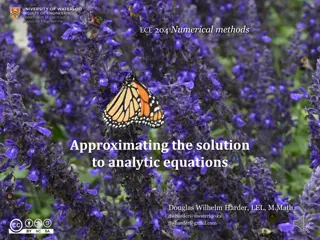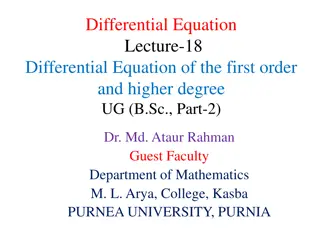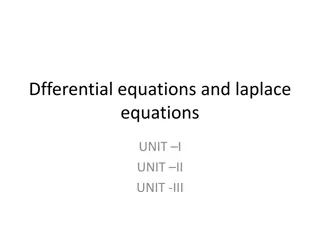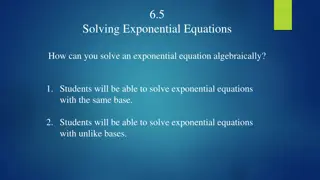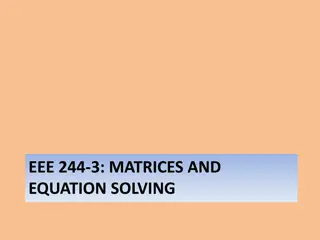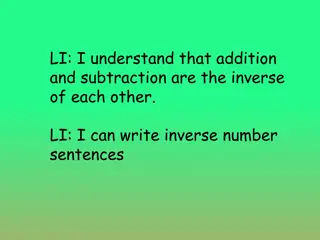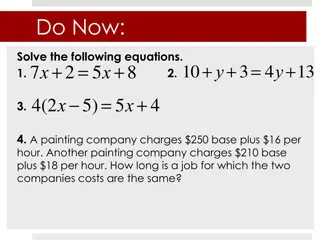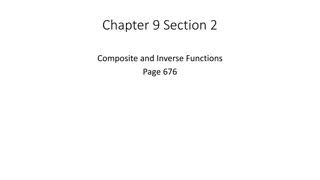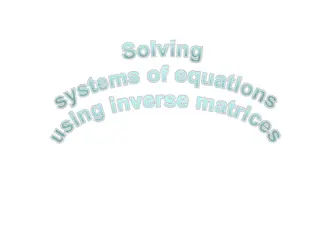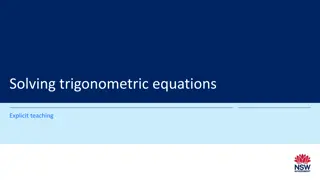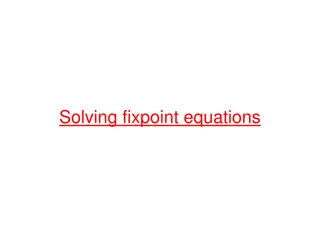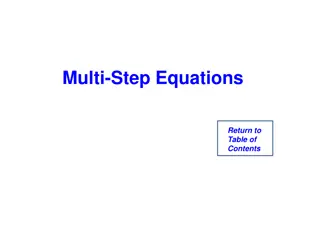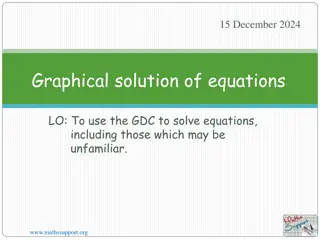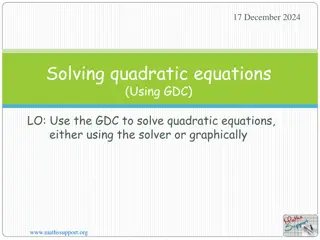Solving Multi-Step Equations Using Inverse Operations
Learn how to solve multi-step equations by applying the distributive property, combining like terms, and using inverse operations. Practice creating equations for real-world situations and check solutions for accuracy. Engage in step-by-step examples to enhance your understanding and mastery of solving equations efficiently.
Download Presentation

Please find below an Image/Link to download the presentation.
The content on the website is provided AS IS for your information and personal use only. It may not be sold, licensed, or shared on other websites without obtaining consent from the author.If you encounter any issues during the download, it is possible that the publisher has removed the file from their server.
You are allowed to download the files provided on this website for personal or commercial use, subject to the condition that they are used lawfully. All files are the property of their respective owners.
The content on the website is provided AS IS for your information and personal use only. It may not be sold, licensed, or shared on other websites without obtaining consent from the author.
E N D
Presentation Transcript
LESSON 1-3 SOLVING MULTI-STEP EQUATIONS LEARNING OBJECTIVE(S): I CAN SOLVE MULTI-STEP EQUATIONS BY USING THE DISTRIBUTIVE PROPERTY; COMBINING LIKE TERMS; AND USING INVERSE OPERATIONS. I CAN CREATE EQUATIONS TO REPRESENT REAL -WORLD SITUATIONS. ESSENTIAL QUESTION: How do I solve Multi-Step Equations?
EX.1: SOLVING MULTI-STEP EQUATIONS I/WE DO: Solve each equation. STEPS: 1. Write the original equation. a.) 2y - 3 = 7 b.) ? 9 - 15 = 12 2. Use the Distributive Property to simplify if needed. 3. Combine like terms to simplify if needed. 4. Undo Addition or Subtraction using inverse operations. 5. Undo Multiplication or Division using inverse operations. 6. Check solution (answer) by substituting back into the equation for the variable to see if it makes the equation true. d.) -12 = - 3x - 9 c.) - x + 15 = 12
EX.1: SOLVING MULTI-STEP EQUATIONS I/WE DO: STEPS: Solve each equation. 1. Write the original equation. 2. Use the Distributive Property to simplify if needed. f.)1 4 3 ? = 6? e.) 4 3? + 1 = 10 ? 4 14? 3? 4 + 3. Combine like terms to simplify if needed. 4. Undo Addition or Subtraction using inverse operations. 5. Undo Multiplication or Division using inverseoperations. g.) b) 2 4? + 3 + 5 = 6 ? 3 + 10? 15 6. Check solution (answer) by substituting back into the equation for the variable to see if it makes the equation true.
EX.1: SOLVING MULTI-STEP EQUATIONS I/WE DO: STEPS: Solve each equation. 1. Write the original equation. h.) 2c + c +12= 78 i.) 3a + 6 + a = 90 2. Use the Distributive Property to simplify if needed. 3. Combine like terms to simplify if needed. 4. Undo Addition or Subtraction using inverse operations. 5. Undo Multiplication or Division using inverse operations. 6. Check solution (answer) by substituting back into the equation for the variable to see if it makes the equation true. j.) -2(b - 4) = 12 k.) 15 = -3(x - 1) + 9
EX. 1: SOLVING MULTI-STEP EQUATIONS CONTINUED YOU DO: Solve each equation. n. 13y + 48 = 8y - 47 m. -3z + 8 + (-2z) = -12 l. -2y + 5 + 5y = 14 o. 3x-7(2x -13) = 3 (-2x + 9) q. 6(t - 2) = 2(9 t) p. m - 5(m - 1) = 7
EX. 2: SOLVING A FORMULA FOR ONE OF ITS VARIABLES. I/WE DO: STEPS: Solve each equation for the indicated variable. 1. Isolate the indicated variable using inverse operations. b. Solve for ??. ? =? ??(??+ ??) c. Solve for w. ? = ?(?? + ?? + ??) a. Solve for h. ? =? ??(??+ ??) 2. State any restrictions on appropriate variables. Solve for x and state any restrictions on appropriate variables. f. ? =?? d. ? ?+ ? =? e. ?? + ?? ?? = ? ?+ ? ?
EX. 2: SOLVING A FORMULA FOR ONE OF ITS VARIABLES. YOU DO: STEPS: Solve each equation. 1. Isolate the indicated variable using inverse operations. i.) Solve for r. ? = ???? g.) Solve for g ? =? h.) Solve for w. ? = ??? ???? 2. State any restrictions on the variable. Solve for x and state any restrictions on appropriate variables. j.) ? ?+ ? =? j.) ? ? k.) ? = ? + ? ?+ ? = ? ? ?
EX. 3: REAL WORLD APPLICATION: STEPS: 1. Mark the text by doing the following: Circle all of the numbers. Underline all of the verbal phrases that go with each number you circled. Draw a rectangle or box around the question in the problem. I/WE DO: Answer each problem using the steps provided.. a.) Geometry: Geometry: The lengths of the sides of a triangle are in the ratio 3:4:5. The perimeter of the triangle is 18 in. Find the lengths of the sides. 2. Define a variable. 3. Write an equation. 4. Solve the Equation. 5. Answer the question in a complete sentence.
EX. 3: REAL WORLD APPLICATION: STEPS: 1. Mark the text by doing the following: Circle all of the numbers. Underline all of the verbal phrases that go with each number you circled. Draw a rectangle or box around the question in the problem. I/WE DO: Answer each problem using the steps provided.. b.) Aeronautics: Aeronautics: Radar detected an unidentified plane 500 miles away, approaching at 700 mi/hr. Fifteen minutes later an interceptor plane was dispatched, traveling at 800 mi/hr. How long did the interceptor take to reach the approaching plane? 2. Define a variable. 3. Write an equation. 4. Solve the Equation. 5. Answer the question in a complete sentence.
EX. 3: REAL WORLD APPLICATION: STEPS: 1. Mark the text by doing the following: Circle all of the numbers. Underline all of the verbal phrases that go with each number you circled. Draw a rectangle or box around the question in the problem. I/WE DO: Answer each problem using the steps provided.. c.) A dog kennel owner has 100 ft. of fencing to enclose a rectangular dog run. She wants it to be 5 times as long as it is wide. Find the dimensions of the dog run. 2. Define a variable. 3. Write an equation. 4. Solve the Equation. 5. Answer the question in a complete sentence.
EX. 3: REAL WORLD APPLICATION: STEPS: 1. Mark the text by doing the following: Circle all of the numbers. Underline all of the verbal phrases that go with each number you circled. Draw a rectangle or box around the question in the problem. I/WE DO: Answer each problem using the steps provided.. d.) Two buses leave Fresno at the same time and travel in opposite directions. One bus averages 55 mph and the other 45 mph. When will they be 400 miles apart? Note: distance = (rate)(time) or d=rt 400 2. Define a variable. 3. Write an equation. 55t 45t 4. Solve the Equation. 5. Answer the question in a complete sentence.
EX. 3: REAL WORLD APPLICATION: STEPS: 1. Mark the text by doing the following: Circle all of the numbers. Underline all of the verbal phrases that go with each number you circled. Draw a rectangle or box around the question in the problem. I/WE DO: Answer each problem using the steps provided.. e.) The sum of three consecutive integers is 90. Find the three integers. 2. Define a variable. 3. Write an equation. 4. Solve the Equation. 5. Answer the question in a complete sentence.
EX. 3: REAL WORLD APPLICATION: STEPS: 1. Mark the text by doing the following: Circle all of the numbers. Underline all of the verbal phrases that go with each number you circled. Draw a rectangle or box around the question in the problem. YOU DO: Answer each problem using the steps provided.. f.) Mike and Adam left a bus terminal at the same time and traveled in opposite directions. Mike s bus was in heavy traffic and had to travel 20 mi/h slower than Adam s bus. After 3 hours, their buses were 270 miles apart. How fast was each bus going? Note: distance = (rate)(time) or d = rt 270 2. Define a variable. 3. Write an equation. Mike Adam 4. Solve the Equation. 5. Answer the question in a complete sentence.
EX. 3: REAL WORLD APPLICATION: STEPS: 1. Mark the text by doing the following: Circle all of the numbers. Underline all of the verbal phrases that go with each number you circled. Draw a rectangle or box around the question in the problem. YOU DO: Answer each problem using the steps provided.. g.) The sides of a triangle are in the ratio 5 : 12 : 13. The sides of a triangle are in the ratio 5 : 12 : 13. What is the length of each side of the triangle if the What is the length of each side of the triangle if the perimeter of the triangle is 15 in.? perimeter of the triangle is 15 in.? 2. Define a variable. 3. Write an equation. 4. Solve the Equation. 5. Answer the question in a complete sentence.
EX. 3: REAL WORLD APPLICATION: STEPS: 1. Mark the text by doing the following: Circle all of the numbers. Underline all of the verbal phrases that go with each number you circled. Draw a rectangle or box around the question in the problem. YOU DO: Answer each problem using the steps provided.. h.) Adrian will use part of garage wall as one of the long sides of a rectangular rabbit pen. He wants the pen to be 3 times as long as it is wide. He plans to use 68 ft. of fencing. Find the dimensions of the rabbit pen. 2. Define a variable. 3. Write an equation. 4. Solve the Equation. 5. Answer the question in a complete sentence.
EX. 3: REAL WORLD APPLICATION: STEPS: 1. Mark the text by doing the following: Circle all of the numbers. Underline all of the verbal phrases that go with each number you circled. Draw a rectangle or box around the question in the problem. YOU DO: Answer each problem using the steps provided.. i.) A space probe leaves Earth at the rate of 3km/s. After 100 days, a radio signal is sent to the probe. Radio signals travel at the speed of light, about 3 105 km/s. About how long does the signal take to reach the probe? 2. Define a variable. 3. Write an equation. 4. Solve the Equation. 5. Answer the question in a complete sentence.
EX. 3: REAL WORLD APPLICATION: STEPS: 1. Mark the text by doing the following: Circle all of the numbers. Underline all of the verbal phrases that go with each number you circled. Draw a rectangle or box around the question in the problem. YOU DO: Answer each problem using the steps provided.. j.) The sum of four consecutive odd integers is 184. Find the four integers. 2. Define a variable. 3. Write an equation. 4. Solve the Equation. 5. Answer the question in a complete sentence.


